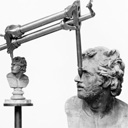0304 Engineers as Artists − Artists as Engineers
The Reproduction of Art Objects at the World’s Fairs
Identifiers (Article)
Abstract
"The Great Exhibition of the Industry of all Nations", held at the Crystal Palace in London in 1851, hosted an array of objects that testified to both artistic and technical virtuosity, while their display served as a spectacle for the public. This paper takes up the rich history of mechanical technologies in the service of art using the example of the machine for reproducing sculptures, which was presented as a cutting-edge innovation at the Great Exhibition. Drawing on the history of early photography and in particular the historical context of various techniques of three-dimensional reproduction (such as the 'photo-sculpture' introduced later in 1862), the process of reproducing and displaying works of art on a small scale will be explored. The study of mechanically minded sculptors, who celebrated the almost magical qualities of their machines and the demonstration of the production processes, reveals their ambition to join the ranks of the great inventors, alongside the situation of the pioneers of early photography. The presentation of sculptures, reliefs and objets d’art in the milieu of technical knowledge, industry and manufacture at the universal exhibition of 1851 is thus put up for discussion, also with a view to subsequent international exhibitions.
Statistics


License

This work is licensed under a Creative Commons Attribution-NonCommercial-NoDerivatives 4.0 International License.



